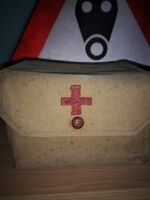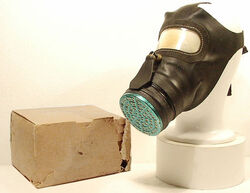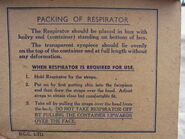Introduction
The General Civilian Respirator was issued to every civilian by the government in the late 1930s and early 1940s. Civilians were legally required to have their gas masks within reach at all times, and there was an extensive propaganda campaign designed to increase awareness.
Mask
The General Civilian Respirator was first designed in 1935. Two of the key design requirements of the mask was it had to be made with as mostly indigenous materials and made as cheaply as possible. The secondary requirement, was, evidently achieved with success. On average, this mask cost 2/11d (2 shillings and 11 pence) to produce. The main producers of this respirator were Avon, Siebe-Gorman and LBR (Leyland & Birmingham Rubber).
Probably as a cost-saving feature, this mask does not feature any kind of exhale valve. Instead, air is expelled out of the sides of the facepiece.
Vision was provided by a thin plastic sheet that was stitched into place. This was a structural weakness of the respirators' design. It was later feared that small amounts of deployed gas could seep through the stitch holes on the front. This flaw was rectified in 1940, the solution being to apply latex luting over the stitched areas to create a gas-proof seal.
The straps of this mask were very basic and simply went over the head (3-pointed harness). The length of the straps could be changed by removing the safety pins and replacing them when the desired length was reached.
Filter
The GCRs filter was attached directly to the mask. Interestingly, very early models (1935) of this mask do not have asbestos in their particulate layers. Instead, the particulate layer consisted of Merino wool impregnated with Carbon Black. This was soon swapped for Merino wool impregnated with asbestos.
In 1940, all GCRs were recalled to be re-fitted with a 'Contex' filter. The contex filter was a small green pre-filter made of anodised aluminium and contained more particulate layers. This was thought necessary: tests had shown the standard filter was hugely lacking in protection against arsenical gases.
Boxes

Example of a handmade/private purchase cover. Judging by the drawn red cross emblem, the previous owner was possibly connected to a First Aid Party organisation
The GCR was issued in a cardboard box, with instructions printed on the inside lid. However, due to private purchases and handmade box covers, there exist many different varieties of storage containers for this mask. The main reason for after-market storage solutions was due to the cardboard being thin, poor quality and a lack of resistance to general wear and tear.
Women had special handbags where they could carry their masks. After the war, unfortunately, many of these masks were cut, at the filter end to make an elastic band which was used as a makeshift slingshot by children.
Elkes biscuit company produced tins for respirator storage, often with painted lines such as 'TAKE CARE OF YOUR GAS MASK' and 'STORE IN A COOL PLACE'. These tins were red and sported a metal opening/closing latch and carrying handle. It should be noted that these tins did not replace the standard issue carboard box, but instead the box was placed inside the tin to protect it.
Home Guard units were initially issued the same GCR in the standard cardboard box. Predictably, the cardboard did not survive long during the rigours of training, thus Home Guard units were issued their respirators in cylindrical brown metal tins. These tins were lined with soft fabric and featured a twine carrying strap. Some respirator care instructions were printed on the lids inside.
In addition to the above, E.I. & Co made a octagonal respirator storage tin in the same brown metal as the Home Guard tins. This particular tin opened/closed on hinges. The tins sides' were flanked by metal loops to attach a shoulder strap to.
End of compulsory carrying
However, on 12th October 1939, The Home Secretary announced that the Government no longer considered the carrying of masks in reception areas as 'essential'. This action was motivated by a number of complaints garnered from civilians who were annoyed by over-bearing wardens harassing those who didn't have their masks.
Commonwealth Variants

Flutter Type Valve General Civilian Mask from Johannes' collection (http://gasmasklexikon.com/)
This mask was issued to Commonwealth countries such as; Malta, Canada and New Zealand, all having their own variations (except for Malta). It was made by two main companies Seibe Gorman and Avon. Pictures of this mask's variations can be found in the gallery below.
More information and display of the General Civilian Respirator:

General Civilian Respirator
Gallery
Additional notes: This the filters for this mask and all other British masks from the WW2 era contain Crocidolite also known as "blue asbestos" this form of asbestos is 100 times more dangerous than standard asbestos. To add to the danger of these filters the Arsenic pre filter present on some models is also highly toxic due to Arsenic being a poisonous metal care should be taken when handling this mask and it should be displayed in a closed container. when handling Arsenic components gloves should be worn as well as a Respirator if it is not in a solid state (same applies for the asbestos filter being loose which further encourages use of a Respirator) Wash hands and dispose of gloves after handling.
References:
http://gasmasklexikon.com/ (Johannes' collection)










